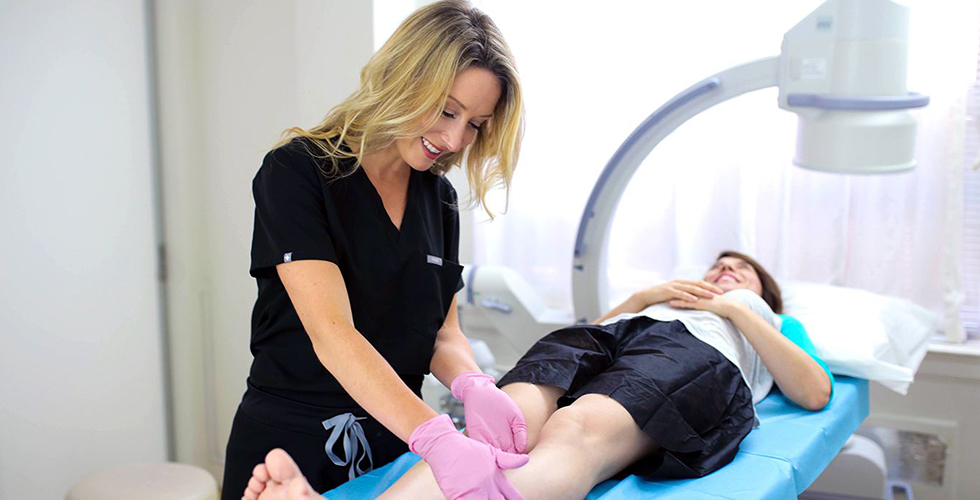What happens during vein stripping with ligation?
If you’re wondering about the varicose vein stripping steps, it’s possible you have been informed that you need varicose vein surgery. Before we answer your question, we believe you should have some general information about vein treatments. While vein stripping and vein ligation are still offered by many vein treatment clinics and medical centers, they are largely considered to be outdated or obsolete treatments. Vein stripping and vein ligation are complex surgical procedures that involve hospitalization, weeks of downtime, and a high risk of complications.

Vein stripping is a surgical procedure performed under general anesthesia. The varicose vein surgeon makes a large incision on your body to access the underlying diseased veins. The vein doctor uses specialized surgical tools to extract the diseased vein. The treatment may involve major excisions, grafts, venous bypass, and other complex techniques. In the past, vein stripping and vein ligation were standard treatments for chronic venous insufficiency, the root cause of spider veins and varicose veins
But the field of phlebology has advanced by leaps and bounds over the past decades. Thanks to recent technological innovations, vein doctors can now treat spider veins, varicose veins, and underlying vein disease with extremely safe, minimally invasive treatments that conclude within an hour and involve no downtime. Minimally invasive spider vein and varicose vein treatments are safer, more reliable, and more effective than traditional vein surgeries, such as vein stripping and vein ligation.

Some patients still need vein ligation and vein stripping, but only in extremely severe and complicated cases, and preferably if all minimally invasive treatments have failed. If you have been asked to undergo a vein stripping or vein ligation procedure, please consult another reliable board-certified vein doctor specializing in minimally invasive spider vein and varicose vein treatments. Vascular surgery should always be the last resort if all other solutions fail.
Drawbacks of vein stripping with ligation:
- Hospitalization: Vein stripping and vein ligation are extremely complex surgical procedures performed under general anesthesia in a hospital setting. The procedure involves multiple excisions and a hospital stay.
- General Anesthesia: Vein stripping and vein ligation are performed under general anesthesia, i.e., you are put to sleep during the procedure. General anesthesia carries its own set of risks, so it further increases the procedure’s risks.
- Risk of Recurrence: Vein stripping and vein ligation have a higher risk of recurrence than minimally invasive procedures. That means there’s a chance that your vein disease might return after the surgical procedure.
- Risk of Complications: Vein stripping and vein ligation have higher risks of complications, such as deep vein thrombosis and infections.
- Downtime: Vein stripping and vein ligation involve several weeks of downtime. You have to stay in the hospital for a few days and then rest in your home. That means you have to take several weeks off work.
- Low Success Rate: Vein stripping and vein ligation have a relatively lower success rate compared to advanced minimally invasive treatments.
What are the best varicose vein treatments?
If you have spider veins and varicose veins, you must look for vein doctors specializing in the latest and safest minimally invasive treatments. The best varicose vein treatments are minimally invasive procedures that address the root cause of varicose veins — chronic venous insufficiency. The vein doctor must perform a thorough duplex ultrasound scan to visualize the direction of blood flow in your leg veins, diagnose underlying chronic venous insufficiency, and curate a personalized treatment plan. The following is a brief description of the best spider vein and varicose vein treatments.
Radiofrequency Ablation
The vein doctor makes a small incision on the skin’s surface to insert a catheter into the diseased saphenous vein. When activated, the catheter generates thermal energy to collapse the diseased saphenous vein, rerouting the accumulated blood into healthier leg veins.
Endovenous Laser Ablation
The vein doctor makes a small incision on the skin’s surface to insert a laser fiber into the diseased saphenous vein under ultrasound guidance. When activated, the laser fiber generates laser energy and destroys the diseased vein, restoring optimal blood circulation to the heart.
VenaSeal Treatment
The vein doctor injects a medical-grade adhesive into the diseased saphenous vein to seal its walls shut, rerouting the accumulated blood into healthier leg veins. The diseased vein eventually turns into hardened scar tissues absorbed by the body.
ClariVein
The vein doctor makes a small incision on the skin’s surface to insert a specialized catheter with a rotating wire tip. When activated, the rotating wire destroys the diseased varicose veins while delivering a sclerosant medicine, which shrinks and collapses the diseased vein.
Ambulatory Phlebectomy
The vein physician makes small incisions on the skin’s surface to physically extract the superficial varicose veins and improve your leg’s appearance. The incisions gradually turn into scars that heal and fade away from the skin’s surface.
Sclerotherapy
The vein doctor injects sclerosant medicine into the spider veins to make them shrink, collapse, and get absorbed by the body. The spider veins are eventually absorbed by the body, and they soon fade away from the skin’s surface.
The Vein Treatment Clinic is led by highly-skilled, board-certified, and Harvard-trained vein doctors specializing in cutting-edge spider vein and varicose vein treatments. Our vein doctors always perform thorough ultrasound tests to visualize your blood flow, diagnose the root cause of your vein problems, and curate a personalized vein treatment plan. Our considered approach to vein care ensures safe, reliable, and long-lasting results. Please schedule an appointment to explore your varicose vein treatment options.








